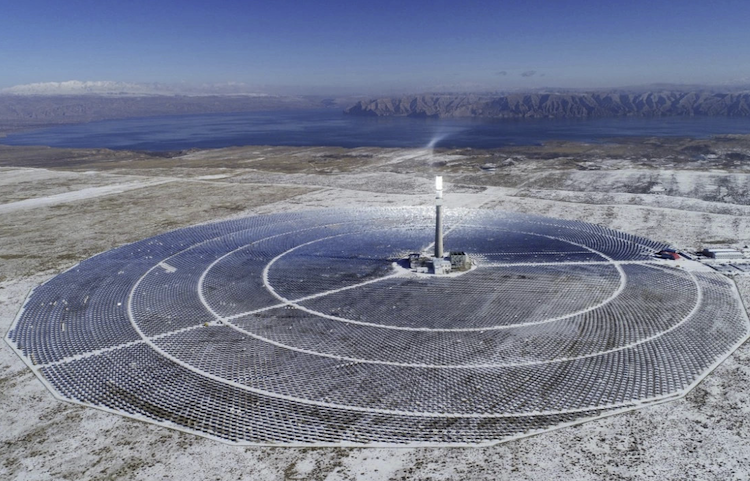Power China has begun construction of the world’s only 200 MW Tower Concentrated Solar Power
Power China has begun construction of the world's only 200 MW Tower Concentrated Solar Power | REVE News of the ... REVE


Power China Northwest Builds 200 MW Tower Concentrated Solar Power (CSP) Project in Haixi
In an innovative move, Power China Northwest is constructing a new Tower Concentrated Solar Power (CSP) project in western Haixi with a capacity of 200 MW, twice the normal size of 100 MW. This increase in capacity may be attributed to advancements in technology that have improved optical efficiency over long distances.


Power China’s First Tower CSP Project: Gonghe 50 MW Tower CSP in Qinghai Province
Tower CSP projects are typically built with a capacity of up to 100 MW. However, Power China Northwest is pushing the boundaries by constructing a tower CSP project with a capacity of 200 MW. This larger project allows for mirrors to be placed further away from the central tower, potentially improving the optical efficiency at long distances. The increased capacity of this project makes it the world’s largest solar tower CSP project in terms of single-unit capacity under construction.
News source: China Solar Thermal Alliance
Northwest Engineering Corporation Limited (POWERCHINA NORTHWEST) has announced the official start of construction for the 200 MW solar tower CSP project in Delingha. The project is being undertaken by POWERCHINA NORTHWEST as an Engineering, Procurement, and Construction (EPC) contractor and is invested by CGN New Energy.
The Delingha solar hybrid project by CGN New Energy has a total capacity of 2000 MW and will be constructed in two phases. Each phase consists of 800 MW of photovoltaic (PV) power and 200 MW of CSP. The construction has begun for the CSP part of the first phase, which is set to become the world’s largest solar tower CSP project in terms of single-unit capacity.
This project adopts a hybrid approach combining photovoltaic and molten salt solar thermal power generation. It utilizes the heat from the solar field and the residual electricity from curtailment wind and solar power in the area to heat the molten salt in the thermal energy storage tank. The heated salt then generates high-temperature steam through a salt-water heat exchanger, which drives a steam turbine generator to produce electricity.
The 200 MW CSP plant is projected to have a total annual utilization of 1,319 hours, resulting in an annual power generation of 263.88 million kWh. Once the entire project is completed and operational, the annual on-grid electricity is expected to reach 3.65 billion kWh. Mr. Ke Xijun, the person in charge of the project, stated that this project aims to become the first new energy hybrid demonstration project in the western part of the Haixi region, contributing to the construction of a national clean energy industry hub in Qinghai Province and supporting the achievement of carbon neutrality goals.
SDGs, Targets, and Indicators
-
SDG 7: Affordable and Clean Energy
- Target 7.1: By 2030, ensure universal access to affordable, reliable, and modern energy services
- Indicator 7.1.2: Proportion of population with access to electricity
- Indicator 7.1.3: Proportion of population with primary reliance on clean fuels and technology
-
SDG 9: Industry, Innovation, and Infrastructure
- Target 9.4: By 2030, upgrade infrastructure and retrofit industries to make them sustainable, with increased resource-use efficiency and greater adoption of clean and environmentally sound technologies and industrial processes
- Indicator 9.4.1: CO2 emission per unit of value added
-
SDG 13: Climate Action
- Target 13.2: Integrate climate change measures into national policies, strategies, and planning
- Indicator 13.2.1: Number of countries that have integrated mitigation, adaptation, impact reduction, and early warning into primary, secondary, and tertiary curricula
Analysis
The article discusses the construction of a new Tower Concentrated Solar Power (CSP) project in western Haixi by Power China Northwest. Based on the content of the article, the following SDGs, targets, and indicators can be identified:
1. SDG 7: Affordable and Clean Energy
This SDG is addressed as the article highlights the use of solar power as a source of clean energy. The construction of the Tower CSP project contributes to the goal of ensuring universal access to affordable, reliable, and modern energy services.
2. Target 7.1: By 2030, ensure universal access to affordable, reliable, and modern energy services
This target is relevant as the Tower CSP project aims to provide affordable and reliable energy services through the use of solar power. It contributes to the goal of ensuring universal access to clean energy.
3. Indicator 7.1.2: Proportion of population with access to electricity
This indicator can be used to measure progress towards the target of universal access to affordable, reliable, and modern energy services. The Tower CSP project will contribute to increasing the proportion of the population with access to electricity.
4. Indicator 7.1.3: Proportion of population with primary reliance on clean fuels and technology
This indicator can also be used to measure progress towards the target of universal access to clean energy. The Tower CSP project promotes the use of clean fuels and technology, reducing reliance on fossil fuels.
5. SDG 9: Industry, Innovation, and Infrastructure
This SDG is connected to the article as the Tower CSP project involves the construction of infrastructure for clean energy generation. It contributes to the goal of upgrading infrastructure and retrofitting industries to make them sustainable.
6. Target 9.4: By 2030, upgrade infrastructure and retrofit industries to make them sustainable, with increased resource-use efficiency and greater adoption of clean and environmentally sound technologies and industrial processes
This target is relevant as the Tower CSP project involves the construction of sustainable infrastructure for clean energy generation. It contributes to the goal of upgrading infrastructure and adopting clean technologies.
7. Indicator 9.4.1: CO2 emission per unit of value added
This indicator can be used to measure the sustainability of the infrastructure and industrial processes involved in the Tower CSP project. It assesses the CO2 emissions associated with the value added by the project.
8. SDG 13: Climate Action
This SDG is connected to the article as the Tower CSP project contributes to mitigating climate change through the use of clean energy. It aligns with the goal of integrating climate change measures into national policies and planning.
9. Target 13.2: Integrate climate change measures into national policies, strategies, and planning
This target is relevant as the Tower CSP project integrates climate change measures by using clean energy sources. It contributes to the goal of incorporating climate change considerations into national policies and planning.
10. Indicator 13.2.1: Number of countries that have integrated mitigation, adaptation, impact reduction, and early warning into primary, secondary, and tertiary curricula
This indicator can be used to measure progress towards the target of integrating climate change measures into education. While not directly mentioned in the article, the Tower CSP project’s contribution to climate action aligns with the need for climate change education.
Table: SDGs, Targets, and Indicators
| SDGs | Targets | Indicators |
|---|---|---|
| SDG 7: Affordable and Clean Energy | Target 7.1: By 2030, ensure universal access to affordable, reliable, and modern energy services | Indicator 7.1.2: Proportion of population with access to electricity Indicator 7.1.3: Proportion of population with primary reliance on clean fuels and technology |
| SDG 9: Industry, Innovation, and Infrastructure | Target 9.4: By 2030, upgrade infrastructure and retrofit industries to make them sustainable, with increased resource-use efficiency and greater adoption of clean and environmentally sound technologies and industrial processes | Indicator 9.4.1: CO2 emission per unit of value added |
| SDG 13: Climate Action | Target 13.2: Integrate climate change measures into national policies, strategies, and planning | Indicator 13.2.1: Number of countries that have integrated mitigation, adaptation, impact reduction, and early warning into primary, secondary, and tertiary curricula |
Behold! This splendid article springs forth from the wellspring of knowledge, shaped by a wondrous proprietary AI technology that delved into a vast ocean of data, illuminating the path towards the Sustainable Development Goals. Remember that all rights are reserved by SDG Investors LLC, empowering us to champion progress together.
Source: evwind.es

Join us, as fellow seekers of change, on a transformative journey at https://sdgtalks.ai/welcome, where you can become a member and actively contribute to shaping a brighter future.







